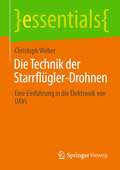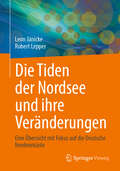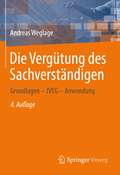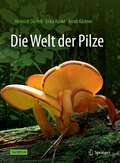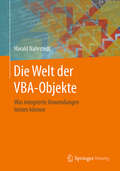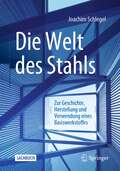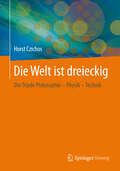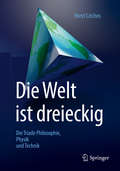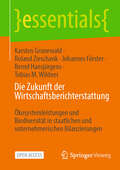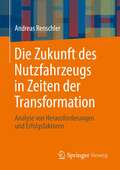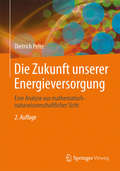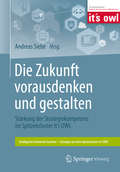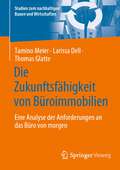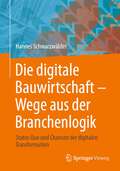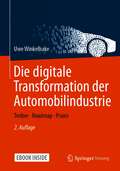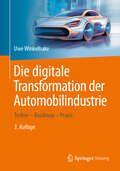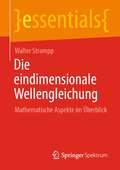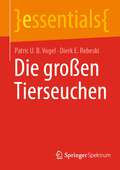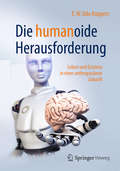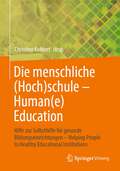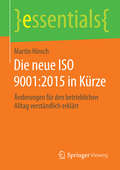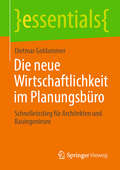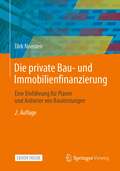- Table View
- List View
Die Technik der Starrflügler-Drohnen: Eine Einführung in die Elektronik von UAVs (essentials)
by Christoph WeberMit zunehmender Popularität werden Drohnen nicht nur privat, sondern auch beispielsweise in der Landwirtschaft oder Wissenschaft erfolgreich eingesetzt. Obwohl es immer wieder zu negativen Schlagzeilen kommt, bleiben sie ein Erfolg. Aber haben Sie sich schon mal Gedanken gemacht, wie Drohnen überhaupt funktionieren? Oder welche Probleme bei der Entwicklung entstehen?Die Elektronik einer Drohne besteht aus einer Vielzahl von Komponenten, die näher beschrieben und ihr Zusammenspiel erklärt wird. Dabei wird die Thematik so erläutert, dass sie auch ohne tiefgreifendes technisches Vorwissen verstanden werden kann.
Die Tiden der Nordsee und ihre Veränderungen: Eine Übersicht mit Fokus auf die Deutsche Nordseeküste
by Leon Jänicke Robert LepperAnhaltende Veränderungen der Tidewasserstände betreffen den Küstenschutz in vielerlei Hinsicht, da die Hochwasser schneller ansteigen als der mittlere Meeresspiegel und damit die dominante Größe für die Entwicklung des Hochwasserschutzes werden können. Dieses Buch fördert das Verständnis und bietet einen einfachen Einstieg in das Thema Tiden in der Nordsee, also dem Wechsel von Hoch- und Niedrigwasser im Ablauf der Gezeiten. Die grundsätzliche Entstehung der Tiden ist erklärt wie auch die Gründe für deren periodische und säkulare Veränderungen, immer mit Bezug auf die Deutsche Nordseeküste. Großräumige und kleinräumige Tideänderungen der Nordsee werden nachvollziehbar und mögliche Auswirkungen lokaler Baumaßnahmen sind dargestellt.
Die UN-Nachhaltigkeitsziele als interdisziplinäre Herausforderung: Aufgaben, Aspekte und Ansätze (Sustainable Development Goals (SDG) – Umsetzung in Praxis, Lehre und Entscheidungsprozessen)
by Christa Reicher Silvio Beier Peter Hense Claudia Klümper Stefan LechtenböhmerDieses Buch gibt Einblicke in die Zielsetzungen und zu den Herausforderungen der Nachaltigkeistzielde der UN. Ausgehend von den Blickwinkeln einzelner Fachdisziplinen wird allgemein verständlich die Zelsetzung mit einem Blick auf europäische Verhältnisse erläutert und mit den Anforderungen an andere Fachdisziplinen verknüpft, die notwendig sind, damit ein Erreichen realistisch und zielführend vorangetrieben werden kann.
Die Vergütung des Sachverständigen: Grundlagen – JVEG – Anwendung
by Andreas WeglageSeit dem 1. Januar 2021 gilt das novellierte JVEG (Justizvergütungs - und entschädigungsgesetz). Auf Grundlage der aktuellen Gesetzgebung beantwortet dieser Kommentar die Fragen und Probleme der Vergütung von Sachverständigen. Auch die Vergütung außergerichtlicher Tätigkeiten nach BGB werden erläutert. Die wesentlichen Merkmale der Struktur und der Inhalte der Vergütungsregeln nach Tätigkeitsgruppen werden klar und übersichtlich erläutert.
Die Welt der Pilze
by Heinrich Dörfelt Erika Ruske Arndt KästnerDieses Sachbuch ist eine populär gestaltete, aber fachlich anspruchsvolle, reich bebilderte Übersicht der allgemeinen, speziellen und der angewandten Mykologie (Pilzkunde). Die Lebensweise der Pilze, die vielfältigen Formen ihrer Sexualität, die Anatomie und Morphologie ihrer Fruchtkörper, ihre Ökologie samt ihrer komplizierten symbiontischen Verflechtungen bis hin zu Fusionssymbiosen werden ebenso erläutert wie die Problematik der Gift- und Speisepilze, der Mykotoxine, der Pilzkulturen, des Pilzschutzes, der Pilzkrankheiten oder des problemreichen Holzabbaus durch Pilze.Pilze begegnen uns alltäglich, sie können mit ihrer Lebensleistungen für uns Menschen großen Nutzen bringen, aber auch gewaltige Schäden verursachen; denken wir z.B. an hochwertige Pilzgerichte mit schmackhaften Trüffeln, aber auch an verheerende Ernteverluste durch pilzliche Kartoffelschädlinge -– an Hochleistungsstämme von Hefepilzen und lästige Nagelpilze im Fußbereich.Das Buch wurde für mykologisch interessierte Naturfreunde geschrieben, die mehr über die Pilze, ihre Rolle in der Natur und ihre Bedeutung für uns Menschen wissen möchten, als im Allgemeinen bekannt ist. Es ist auch für Pilzberater, Studierende biologischer Wissenschaften, für Lehrkräfte und interessierte Praktiker und Praktikerinnen in der Land- und Forstwirtschaft verfasst worden.Die nach Sachgebieten gegliederten Texte ermöglichen es zudem, das Buch als spezielle Lektüre zu nutzen. Das Organismen-Register und die Inhaltsübersichten bieten weitere Möglichkeiten des Einstiegs in den vielgliedrigen Inhalt.
Die Welt der VBA-Objekte: Was integrierte Anwendungen leisten können
by Harald NahrstedtDieses Fachbuch setzt VBA-Kenntnisse voraus. Es beschreibt die Objektmodelle der Office-Anwendungen und zeigt mithilfe integrierter Beispiele die Nutzung der Bibliotheken. Der Leser ist damit in der Lage, aus einer Anwendung heraus mittels VBA andere Anwendungen zu öffnen und zu nutzen. Es werden auch Anbindungen außerhalb der Office-Welt angesprochen.
Die Welt des Stahls: Zur Geschichte, Herstellung und Verwendung eines Basiswerkstoffes
by Joachim SchlegelDie Welt des Stahls entwickelt sich ständig weiter und ist inzwischen erstaunlich vielfältig, ja so komplex geworden, dass sie in der Praxis nicht leicht zu überblicken ist. Dem Leser soll diese Welt etwas näher gebracht werden, von der Stahlerzeugung, dem Block- und Strangguss, dem Umformen und der mechanischen Bearbeitung bis hin zur Fertigstellung, Prüfung und Verpackung der Produkte, den dabei vorwiegend genutzten Verfahren und Anlagen einschließlich der umweltgerechten Verwertung und Entsorgung von Abfällen.
Die Welt ist dreieckig: Die Triade Philosophie – Physik – Technik
by Horst CzichosDiese Buch stellt in prägnanter Form die Entwicklung und den Wissensstand der drei Gebiete Philosophie, Physik und Technik dar und will zum multidisziplinären Verständnis der Welt beitragen.
Die Welt ist dreieckig: Die Triade Philosophie – Physik – Technik
by Horst CzichosDieses Sachbuch stellt in prägnanter Form die Entwicklung und den Wissensstand der drei Gebiete Philosophie, Physik und Technik dar und will zum multidisziplinären Verständnis der Welt beitragen.
Die Zukunft der Wirtschaftsberichterstattung: Ökosystemleistungen und Biodiversität in staatlichen und unternehmerischen Bilanzierungen (essentials)
by Bernd Hansjürgens Karsten Grunewald Roland Zieschank Johannes Förster Tobias M. WildnerDieses Open Access-Buch zeigt, wie der Wert von Ökosystemleistungen und biologischer Vielfalt im Sinne einer ehrlichen Rechnung besser in nationale Berichte und Unternehmensbilanzen integriert werden kann. Wirtschaftlicher und sozialer Wohlstand hängen entscheidend von einer intakten, artenreichen Natur ab. Der wahre Wert des Naturvermögens und funktionierender Ökosysteme wird häufig unterschätzt – sowohl in seiner Bedeutung für den Einzelnen, wie auch in volkswirtschaftlichen Berechnungen und Unternehmensbilanzen.
Die Zukunft des Nutzfahrzeugs in Zeiten der Transformation: Analyse von Herausforderungen und Erfolgsfaktoren
by Andreas RenschlerIn einem arbeitsteiligen, flexiblen und vernetzten Wirtschaftssystem ist und bleibt der Straßengüterverkehr das Zugpferd für Wachstum und Wohlstand. Allerdings wandeln sich sowohl die Ansprüche der Gesellschaft an den Transportsektor als auch der Bedarf der Transporteure, die sich in einer Welt hochgradig rationalisierter Transportketten behaupten müssen. Gleichzeitig sind die technischen Potenziale, die Automatisierung, Digitalisierung und Elektrifizierung bieten, derzeit erst in geringem Maße erschlossen. Im globalen Wettbewerb werden sich jene Hersteller durchsetzen, die den Veränderungsbedarf frühzeitig annehmen und neue Technologien mit hohen Stückzahlen und vergleichsweise geringen Stückkosten in den Markt bringen. Dafür muss die Nutzfahrzeugindustrie nicht nur ihre Produkte, sondern auch ihr Führungsverhalten und insgesamt ihr klassisches Geschäftsmodell transformieren. Der Autor beschreibt, welche Veränderungen in der eher konservativen Branche nicht nur möglich, sondern auch notwendig sind.
Die Zukunft unserer Energieversorgung: Eine Analyse aus mathematisch-naturwissenschaftlicher Sicht
by Dietrich PelteDas Buch behandelt die Energie als Mittel zur Entropieerzeugung, welche die Voraussetzung für alle auf der Erde ablaufenden Prozesse ist. Die verfügbaren Energieträger werden unterschieden in erneuerbar und nichterneuerbar. Für letztere wird ihre Reichweite mithilfe mathematischer Modelle berechnet, wobei die Entwicklung der Bevölkerungszahlen und des Lebensstandards berücksichtigt werden. Anhand physikalischer Gesetze wird untersucht, in welchem Umfang erneuerbare Energien den Verlust an nichterneuerbaren Energien ersetzen können. Gleichzeitig definieren diese Gesetze eine Grenze, welche Wachstumsprozesse auf der Erde nicht überschreiten dürfen.
Die Zukunft vorausdenken und gestalten: Stärkung Der Strategiekompetenz Im Spitzencluster It's Owl (Intelligente Technische Systeme – Lösungen aus dem Spitzencluster it’s OWL)
by Andreas SiebeDas Buch beschreibt anschaulich die Ergebnisse der Nachhaltigkeitsmaßnahme „it’s owl – VorZug; Vorausschau – Die Zukunft vorausdenken und gestalten“ des Spitzencluster it’s owl – Intelligente technische Systeme Ostwestfalen-Lippe.Vorausschau und die effiziente Integration der Ergebnisse in die Planungsprozesse ist bereits heute ein erfolgsentscheidender Faktor. Unternehmen, die dies nicht nutzen, landen häufig mit den falschen Produkten zur falschen Zeit am Markt. Dies wird unterstrichen durch eine Studie von Cooper (2001), derzufolge 24% aller untersuchten fehlgeschlagenen Innovationen haupt-sächlich an „unzureichender Marktanalyse“, 16% an „Produkten, die nicht den Erwartungen entsprechen“ und 14% an „ungenügendem Marketingaufwand“ (zugleich den drei insgesamt auch am häufigsten genannten Ursachen) scheitern, wohingegen bei lediglich 6% „technische Probleme bei der Entwicklung“ als Hauptursache angegeben worden ist. Es gilt, die daraus resultierenden Fehlinvestitionen durch Vorausschau zu minimieren.Ziel des Vorhabens, war ein Instrumentarium, welches Inhalte, Methoden und IT-Werkzeuge für den Frühaufklärungsprozesses beinhaltet und den Cluster als Ganzes, aber insbesondere auch die Clusterunternehmen befähigt, wirkungsvoll und effizient Vorausschau zu betreiben und daraus die erforderlichen Schlüsse für die Entwicklung von Geschäfts-, Produkt- und Technologiestrategien zu ziehen. Neben den einzelnen Bausteinen der Betrachtung werden insbesondere auch die Erkenntnisse aus den Pilotprojekten ausgeführt.
Die Zukunftsfähigkeit von Büroimmobilien: Eine Analyse der Anforderungen an das Büro von morgen (Studien zum nachhaltigen Bauen und Wirtschaften)
by Thomas Glatte Tamino Meier Larissa DellBüroimmobilien und die Anforderungen an dieselben erfahren aktuell einen enormen Wandel. Insbesondere die Treiber Nachhaltigkeit und New Work sorgen für veränderte Ansprüche an eine zukunftsfähige Büroimmobilie. Dieses Werk beschäftigt sich mit einer ganzheitlichen Betrachtung dieser Aspekte und der Klärung der Fragestellung, welche essenziellen Anforderungen an eine zukunftsfähige Büroimmobilie in Bezug auf New Work und Nachhaltigkeit entstehen.Diese Publlikation ist Teil der Schriftenreihe Studien zum nachhaltigen Bauen und Wirtschaften.
Die digitale Bauwirtschaft - Wege aus der Branchenlogik: Status Quo und Chancen der digitalen Transformation
by Hannes SchwarzwälderDieses Fachbuch befasst sich mit den grundlegenden Herausforderungen der Bauwirtschaft und den Möglichkeiten, die digitale Transformation zu deren Bewältigung einzusetzen. Aufbauend auf den bekannten Begrifflichkeiten soll ein Weiterdenken stattfinden, wie die Bauwirtschaft die digitale Transformation umsetzen kann und den Einflüssen, welche auf die Branche wirken, gerecht werden kann, ohne dass die Digitalisierung ausschließlich zu deren Selbstzweck eingesetzt wird. Es werden grundlegende Notwendigkeiten für die Digitalisierung in der Bauwirtschaft herausgearbeitet und in den Kontext der zukünftigen Ausrichtung des Wirtschaftsbereichs gestellt.
Die digitale Transformation der Automobilindustrie: Treiber - Roadmap - Praxis
by Uwe WinkelhakeDie vorliegende 2. Auflage des Buches gibt umfassende und pragmatische Handlungsempfehlungen für die digitale Transformation der Automobil- und Zulieferindustrie. Sie wurde um aktuelle Praxisbeispiele und Technologieaspekte besonders in den Bereichen Autonomes Fahren und der Fahrzeug-IT erweitert.Im Mittelpunkt steht der Wandel vom fahrzeugfokussierten hin zu einem mobilitätsorientierten Geschäftsmodell. Ausgehend von den Treibern des digitalen Wandels werden vier Digitalisierungsfelder strukturiert und eine Roadmap zu deren Transformation vorgestellt. Der Weg hin zur automatischen hoch effizienten Abwicklung von schlanken, integrierten Geschäftsprozessen wird ebenso erörtert wie die massive Veränderung von Vertriebs-, Aftersales- und Marketingstrukturen mit der Neugestaltung von Kundenbeziehungen. Umfassende Datennutzung und der Einsatz von künstlicher Intelligenz sind hierbei zentrale Lösungsbausteine. Auch die Möglichkeiten moderner Informationstechnologie wie Hybrid-Cloud Architekturen, container-basierter Microservices und Digital Twin werden aufgezeigt. Die nachhaltige Veränderung der Unternehmenskultur, organisatorische Aspekte und auch agile Methoden zum Projektmanagement und für die Ideenfindung als Basis innovativer Lösungen werden als kritische Erfolgsfaktoren im Detail behandelt. Ausgewählte Praxisbeispiele für innovative Digitalisierungsprojekte vermitteln zusätzliche Ideen und Impulse. Ein Ausblick in die Auto-Mobilität und die Arbeitswelt im Jahr 2040 rundet die Ausführungen ab.
Die digitale Transformation der Automobilindustrie: Treiber - Roadmap - Praxis
by Uwe WinkelhakeDieses Buch gibt umfassende und pragmatische Handlungsempfehlungen für die sich gerade in den letzten Jahren immer rasanter verändernde Automobil- und Zulieferindustrie. China hat sich zum Leitmarkt für E-Mobilität und für die Nutzung von autonom fahrenden Robtaxis, KI und Daten entwickelt. Die etablierten Hersteller müssen sich auf Basis klarer Zielsetzungen noch viel schneller verändern, um nicht den Anschluss zu verlieren und um die Pariser Klimaziele noch erreichen zu können. Die Industrie wandelt sich umfassend von einem fahrzeugfokussierten hin zu einem mobilitätsorientierten Geschäftsmodell. Mehr und mehr Prozesse, sogar ganze Geschäftsfelder werden KI-basiert automatisch ablaufen und mit neuen Technologien verändern sich Vertriebs- und Aftersales-Strukturen. Es entstehen immer mehr Daten, die auch neue, profitable Produkte ermöglichen. Die Umstellung auf E-Fahrzeuge mit entsprechendem Lade-Umfeld, die Nutzung von Mobilitätsservices anstelle Autobesitz, klimaneutralen Produktion und auch die Kreislaufwirtschaft sind beschleunigt anzugehen. Zu den weiterhin zwingend erforderlichen digitalen Transformationen und unter Beachtung der neuesten Entwicklungen gibt das Buch in der nun dritten vollständig überarbeiteten Auflage umfassende und pragmatische Antworten auf aktuelle Fragen: Wie sind neue Technologien strukturiert einzusetzen und wo wird KI zu erheblichen Änderungen führen? Wie ist die Transformation mit welchen Schwerpunktthemen anzugehen? Der Ausblick über das Jahr 2040 hinaus am Ende des Buches wurde erweitert und es werden die zu erwartenden Veränderungen der Arbeitswelt, gerade unter KI-Aspekten, betrachtet.
Die eindimensionale Wellengleichung: Mathematische Aspekte im Überblick (essentials)
by Walter StramppDie Wellengleichung besitzt vielseitige Anwendungen und reichhaltige Facetten. Diese müssen jedoch oft mühsam zusammengetragen werden. Mathematische Aspekte der Wellengleichung werden deshalb in diesem essential in einer Gesamtschau geschildert. Sämtliche mit der Wellengleichung verbundenen Anfangs- und Randwertprobleme werden einbezogen. Klassische Lösungsmethoden mitsamt ihren Querverbindungen werden vorgestellt. Die Methode der charakteristischen Parallelogramme wird durch den Einsatz der Diffenzengleichungen erweitert.
Die gesetzliche Basis und Förderinstrumente der Energiewende: Aktueller Stand des EEG und des KWK-G (essentials)
by Jörg SchefflerJörg Scheffler stellt die wesentlichen, vor allem technischen Inhalte des Erneuerbare-Energien-Gesetzes und des Kraft-Wärme-Kopplungsgesetzes vor, die Schwerpunkte der gesetzlichen Basis der Energiewende sind. Im Vordergrund stehen dabei neben den Kosten und deren Umlage auch Aspekte der Netzanbindung und des Netzbetriebs. Der Autor bietet damit einen aktuellen Überblick über die seit etwa dem Jahr 2000 in Deutschland stattfindende Umstrukturierung der Elektroenergieversorgung, die in diesem Umfang weltweit einmalig ist. Ein umfangreiches Literaturverzeichnis ermöglicht es, auch künftig schnell auf aktuelle Informationen zugreifen zu können.
Die großen Tierseuchen (essentials)
by Patric U. Vogel Dierk E. RebeskiSeit jeher wird die landwirtschaftliche Nutztierhaltung durch grassierende Tierseuchen und damit einhergehend die Nahrungsversorgung des Menschen mit Protein tierischen Ursprungs bedroht. Die Tierseuchenbekämpfung wird national und international per Verordnung und Gesetz geregelt, die u.a. umfangreiche Maßnahmen für die Errichtung von Sperrzonen, Keulung infizierter Tierbestände, Erstellung von Hygienevorschriften, Etablierung diagnostischer Methoden, Optimierung der Tierhaltung, präventive Verwendung von Impfstoffen, usw. gewährleisten. In diesem Buch werden beispielgebend einige der gefürchteten viralen Tierseuchen der Spezies Rind, Schaf, Ziege, Schwein, Pferd und Huhn beschrieben.
Die humanoide Herausforderung: Leben und Existenz in einer anthropozänen Zukunft
by E.W. Udo KüppersCui bono? – Wem nutzt die Entwicklung humanoider Maschinen oder Automaten? Dieses Buch erörtert die Details dieses Spannungsfelds und die Herausforderung gesellschaftlicher Weiterentwicklung. Als technisch-elektronische Handhabungsgeräte können sie den Menschen zuträglich sein, sie von körperlich belastenden Arbeiten oder sogenannten Routinearbeiten befreien. Der Autor versucht die Fragen zu beleuchten: Was erwartet die Menschheit durch die Entwicklung einer künstlichen Intelligenz in einer menschähnlichen Maschine? Was aber, wenn der selbstbestimmende Mensch an der Schwelle steht, sich selbst durch intelligente selbstorganisierte Produkte und Prozesse eine humanoide Konkurrenz zu schaffen, die er möglicherweise nicht mehr kontrollieren kann?
Die menschliche (Hoch)schule - Human(e) Education: Hilfe zur Selbsthilfe für gesunde Bildungseinrichtungen - Helping People to Healthy Educational Institutions
by Christine KohlertDie neue Lernwelt hat viele verschiedene Perspektiven - positive und negative. Aber was bedeutet das für den einzelnen Menschen, wie findet er sich in der neuen Lernwelt zurecht, was beeinflusst ein positives Lernerlebnis und was kann man selbst dazu beitragen. Das Buch analysiert und gibt Hilfestellung sowohl für die Planungsphase als auch für Bestandsveränderungen. Darüber hinaus unterstützt es die Menschen, sich in dieser Bildungswelt zurecht zu finden und wohl zu fühlen.
Die neue ISO 9001: Änderungen für den betrieblichen Alltag verständlich erklärt (essentials)
by Martin HinschMartin Hinsch vermittelt dem Leser das Wichtigste in Kürzezur Normenumstellung der neuen ISO 9001:2015. Zu jedem einzelnen Normenkapitelwerden dazu alle wesentlichen Änderungen erklärt. Der Autor richtet sich damitvor allem an jene QM-Interessierten, die bereits Kontakt mit der alten ISO9001:2008 hatten und nun knapp und präzise über alle für den betrieblichenAlltag wichtigen Neuerungen informiert werden möchten. Für detailliertereInformationen werden die Leser auf das Grundlagenwerk ,,Die neue ISO 9001:2015 -Ein Praxis-Ratgeber für die Normenumstellung" von Martin Hinsch verwiesen.
Die neue Wirtschaftlichkeit im Planungsbüro: Schnelleinstieg für Architekten und Bauingenieure (essentials)
by Dietmar GoldammerAufgrund des Fortfalls der Mindestsätze der HOAI müssen Planungsbüros wirtschaftlich umdenken und sich neu aufstellen. Aber wie kann solch eine veränderte Strategie aussehen und welche betriebswirtschaftlichen Parameter sind zu berücksichtigen? Zunehmend kommen auch sogenannte weiche Erfolgsfaktoren ins Spiel. Dieses essential gibt Denkanstöße und zeigt auf, wie ein ruinöser Preiswettbewerb vermieden werden kann.
Die private Bau- und Immobilienfinanzierung: Eine Einführung für Planer und Anbieter von Bauleistungen
by Dirk NoostenBei allen Fragen rund um die private Bau- und Immobilienfinanzierung unterstützt dieses Werk den Planer als Berater des Bauherren. Dabei werden Begrifflichkeiten der Baufinanzierung erläutert, Darlehensformen und Regelungen in Darlehensverträgen besprochen, Haushaltspläne aufgestellt und verschiedene Finanzierungsbausteine erklärt. Zahlreiche Beispiele und Übungsaufgaben vertiefen die Thematik.
